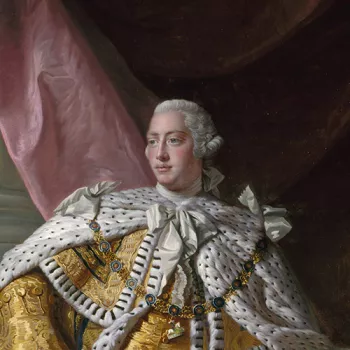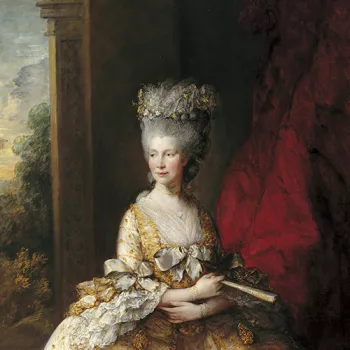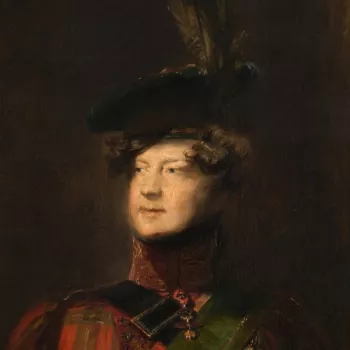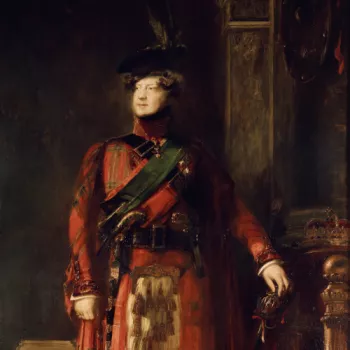George IV’s visit to Edinburgh
The story of the king’s historic visit and its lasting impact.

Reading time: 6 minutes
From 15-29 August 1822, George IV visited Edinburgh. He was the first reigning British monarch to come to Scotland in almost 200 years.
It was an occasion filled with great significance as it was the first visit by a monarch since that of Charles II in 1651 for his Scottish coronation, and the first since the Act of Union joined the parliaments of England and Scotland in 1707 to create the United Kingdom.
A royal visit
After George’s accession to the throne in 1820, there was an ambition to make him as visible as possible around his kingdom. The visit, which became known as the ‘King’s Jaunt’, followed on from the immensely popular tours in 1821 of the king’s other outlying kingdoms, Ireland and Hanover.
The royal visit to Scotland, caricatured as ‘one and twenty daft days’, was a significant occasion, which helped inspire a national identity founded on the symbolism of tartan. Scotland had its own monarchical traditions, and its own Crown Jewels, known as the Honours of Scotland. Sir Walter Scott, the well-known writer, had re-discovered these in Edinburgh Castle in 1818.
Ceremony and spectacle
The Palace of Holyroodhouse in Edinburgh was not in a good enough state of repair for the king to stay there. He instead lodged at Dalkeith Palace, seat of the Dukes of Buccleuch, outside the city. Renovations were hastily undertaken so that formal events could take place at Holyrood, the ancient residence of the Scottish monarchs.
Following George’s formal procession into the city, at the Palace of Holyroodhouse he was received as king in a spectacular and symbolic ceremony, where he was presented with the keys by the Hereditary Keeper of the Palace, the Duke of Hamilton. The Scottish artist, Sir David Wilkie, was commissioned by the king to record the moment where he is about to enter the palace of his ancestors. The Honours of Scotland (the Crown, Sword and Sceptre) are displayed on horseback as the king, wearing Field-Marshal uniform, is acknowledged as the legitimate holder of the keys, and so the rightful king of Scotland.
The artist has imaginatively captured the scene outside the palace. In the painting, enthusiastic spectators clamber over every part of the palace to catch a view of the king. However in reality the king went straight inside and was presented with the Honours of Scotland in the Presence Chamber.
Sir Walter Scott
Sir Walter Scott has often been seen as instrumental in arranging the entire royal visit. He had previously been invited to dinner at Carlton House, London in 1815 and had attended the coronation in Westminster Abbey. In his novels, Scott recreated a romantic view of Scotland’s past, inspired in part by his position as chairman of the Celtic Society which promoted Highland culture and dress.
Under Scott’s careful stage management, George was presented as the latest in a long line of Scottish monarchs, heir to both the Hanoverians and the Jacobites, of a country with a distinctive and unified highland identity. This was emphasised by Scott himself:
We are THE CLAN and our king is THE CHIEF
The king’s Highland dress
Highland dress had been banned following the Jacobite rising of 1745, but since the lifting of the ban, wearing tartan had become more widespread. Tartan attire was encouraged during the visit and George IV himself was persuaded to order a Highland dress outfit, which he wore at a levée or reception held at the Palace of Holyroodhouse.
The portrait by Sir David Wilkie commemorates the occasion. The king appeared magnificent in full Highland dress, from George Hunter & Co., an Edinburgh-based firm. 1200 gentlemen attended the levée, and all were encouraged to wear tartan. Around 15 gentlemen were presented every minute, which gave each attendee just 4 seconds with the king.
The artist has depicted the king as utterly majestic: in actual fact, George wore buff-coloured trousers or ‘flesh-coloured pantaloons’ under his kilt and stockings to keep warm and was made fun of for doing so. His kilt was also too short, and one noted society wit commented:
Since he is to be amongst us for so short a time, the more we see of him the better!
The outfit, which includes the accoutrements of a dirk, sword, powder flask, belt, sash and pair of pistols, was supplied by George Hunter & Co. of Princes Street, Edinburgh, at a cost of £1354 18s., the equivalent of over £140,000 today. The bill for this survives in the Royal Archives and includes 61 yards of royal satin plaid [tartan], 31 yards of Royal velvet, and 17 ½ yards of royal plaid cashmere. See the bill (RA GEO/MAIN/29600) on the Royal Archives Georgian Papers Online catalogue.
The majestic sword, of blued steel and damascened in gold, features many Scottish symbols, including the national emblem of the Thistle, St Andrew, a Highland chieftain, and the Badge and Chain of the Order of the Thistle, the highest order of chivalry in Scotland.
A drawing room, or reception, was held for ladies at the Palace. Scott demanded that 'they must all appear in Court plumes and fans. At least nine feathers must be in each headdress.' 457 ladies ‘of the most distinguished rank, fashion and beauty in Scotland’ attended, with each receiving a kiss on the cheek from the king.
The legacy of the visit
The visit continued with a number of extremely well attended events, including a Highland ball, a visit to the theatre and a review of troops. The most significant moment during the visit was a procession in which the Honours of Scotland escorted the King along the Royal Mile from Holyrood to the Castle. At the top despite the poor weather, George stood and waved his hat to the crowds for a quarter of an hour acknowledging their cheers. When one of his attendants expressed concern that he would get wet the King replied 'O, never mind, I must cheer the people.'
The creation of souvenirs surrounding the visit encouraged the use of local materials and local craftsmanship. A citrine (a yellow variety of quartz), engraved with a view of the Castle on one side and the king on the other, was created as a remembrance of the event.
Our king has seen his people, and they have seen their king
The visit, which was witnessed by one-seventh of the Scottish population, was a huge success. The king himself was gratified by how well the visit had gone and departed delighted by Scott's presentation of Scotland as an ancient and traditional clan society, designed to heal the rift between Hanoverian monarch and his northern kingdom.











